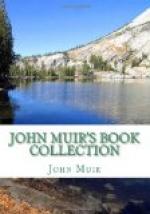I have observed scenery-hunters of all sorts getting first views of yosemites, glaciers. While Mountain ranges, etc. Mixed with the enthusiasm which such scenery naturally excites, there is often weak gushing, and many splutter aloud like little waterfalls. Here, for a few moments at least, there is silence, and all are in dead earnest, as if awed and hushed by an earthquake—perhaps until the cook cries “Breakfast!” or the stable-boy “Horses are ready!” Then the poor unfortunates, slaves of regular habits, turn quickly away, gasping and muttering as if wondering where they had been and what had enchanted them.
Roads have been made from Bright Angel Hotel through the Cocanini Forest to the ends of outstanding promontories, commanding extensive views up and down the canon. The nearest of them, three or four miles east and west, are McNeil’s Point and Rowe’s Point; the latter, besides commanding the eternally interesting canon, gives wide-sweeping views southeast and west over the dark forest roof to the San Francisco and Mount Trumbull volcanoes—the bluest of mountains over the blackest of level woods.
Instead of thus riding in dust with the crowd, more will be gained by going quietly afoot along the rim at different times of day and night, free to observe the vegetation, the fossils in the rocks, the seams beneath overhanging ledges once inhabited by Indians, and to watch the stupendous scenery in the changing lights and shadows, clouds, showers, and storms. One need not go hunting the so-called “points of interest.” The verge anywhere, everywhere, is a point of interest beyond one’s wildest dreams.
As yet, few of the promontories or throng of mountain buildings in the canon are named. Nor among such exuberance of forms are names thought of by the bewildered, hurried tourist. He would be as likely to think of names for waves in a storm. The Eastern and Western Cloisters, Hindu Amphitheater, Cape Royal, Powell’s Plateau, and Grand View Point, Point Sublime, Bissell and Moran points, the Temple of Set, Vishnu’s Temple, Shiva’s Temple, Twin Temples, Tower of Babel, Hance’s Column—these fairly good names given by Dutton, Holmes, Moran, and others are scattered over a large stretch of the canon wilderness.
All the canon rock-beds are lavishly painted, except a few neutral bars and the granite notch at the bottom occupied by the river, which makes but little sign. It is a vast wilderness of rocks in a sea of light, colored and glowing like oak and maple woods in autumn, when the sun-gold is richest. I have just said that it is impossible to learn what the canon is like from descriptions and pictures. Powell’s and Dutton’s descriptions present magnificent views not only of the canon but of all the grand region round about it; and Holmes’s drawings, accompanying Dutton’s report, are wonderfully good. Surely faithful and loving skill can go no further in putting the multitudinous decorated forms on paper. But the colors, the living, rejoicing colors, chanting morning and evening in chorus to heaven! Whose brush or pencil, however lovingly inspired, can give us these? And if paint is of no effect, what hope lies in pen-work? Only this: some may be incited by it to go and see for themselves.




